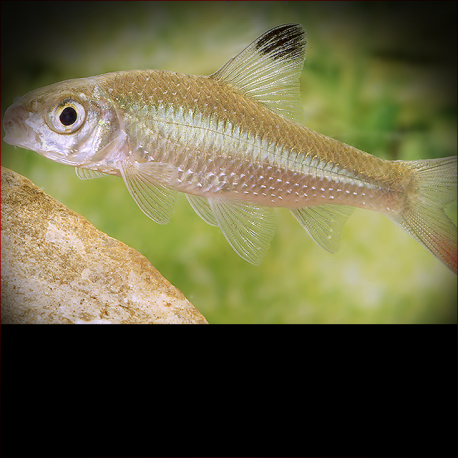More info
Datasheet
| Minimum Tank Size | 270 litres / 71.33 US gallons |
| Maximum Size | 10.0cm / 3.94inches |
| Temperature | 21°C / 69.80°F - 26°C / 78.80°F |
| Hardness | 2.02dgH / 36ppm - 12.05dgH / 215ppm |
| pH | 6.0-7.5 |
General Description
Discherodontus halei, a member of the Cyprinidae family, is a relatively undocumented species in the aquarium trade due to its delicate nature during shipping. The genus was established in 1989 by Roberts to combine three species previously classified under other genera. Known for possessing two rows of pharyngeal teeth, distinguishing them from closely-related species, D. halei is most akin to Indian genera such as Chagunius and Hypselobarbus.
Aquarium Setup
For optimal health and behavior, it is recommended to mimic a flowing river environment in the aquarium, replicating conditions similar to its natural habitat. A setup with variably-sized rocks, gravel, water-worn boulders, and driftwood creates a suitable environment. Hardy aquatic plants like Microsorum, Bolbitis, or Anubias can be attached to decor, providing natural grazing spots. Regular maintenance including 30-50% water changes weekly and ensuring high oxygen levels and moderate water flow are crucial for the well-being of D. halei.
Behaviour
Discherodontus halei is likely to exhibit peaceful behavior and is best suited for community tanks with non-aggressive species that require well-oxygenated water. This schooling fish thrives in groups of at least six, reducing stress and enhancing natural group dynamics. Males may display vibrant colors as they vie for female attention in a group setting.
Feeding and Diet
In their natural habitat, Discherodontus species predominantly feed on aquatic and terrestrial invertebrates. In an aquarium setting, they should be offered a diet consisting of live and frozen foods such as chironomid larvae, Daphnia, Artemia, and quality dried flakes and granules. These fish may also exhibit grazing behavior on biofilm that forms on rock structures in a river-style tank setup.
Reproduction & Dimorphism
Information regarding the reproduction of Discherodontus halei remains unreported. Sexually mature females are typically thicker-bodied and slightly larger than males, allowing for visible sexual dimorphism in mature specimens.
Habitat and Distribution
Discherodontus halei inhabits clear, fast-flowing minor rivers and forest streams in regions such as central Peninsular Malaysia and the Mae Klong and Chao Phraya river systems in Thailand. These areas feature minimal aquatic plants, with submerged roots, emergent species, leaf litter, and fallen branches providing essential habitat components.
Distribution
The species of Discherodontus halei are distributed across regions including Pahang state in central Peninsular Malaysia and the Mae Klong and Chao Phraya river systems in Thailand, with a significant absence in Peninsular Thailand. The type locality for this species is specified as the "Pahang River, Kuala Tembeling, eastern slope of Sangka Dua Pass, Malaysia," at an approximate elevation of 2000 feet.
Etymology
The genus name "Discherodontus" is derived from Ancient Greek roots meaning "twice," "series," and "tooth," referring to the species' possession of two rows of pharyngeal teeth. The species epithet "halei" honors Mr. Abrahan Hale, the chairman of the Selangor Museum Committee during the species' discovery.

